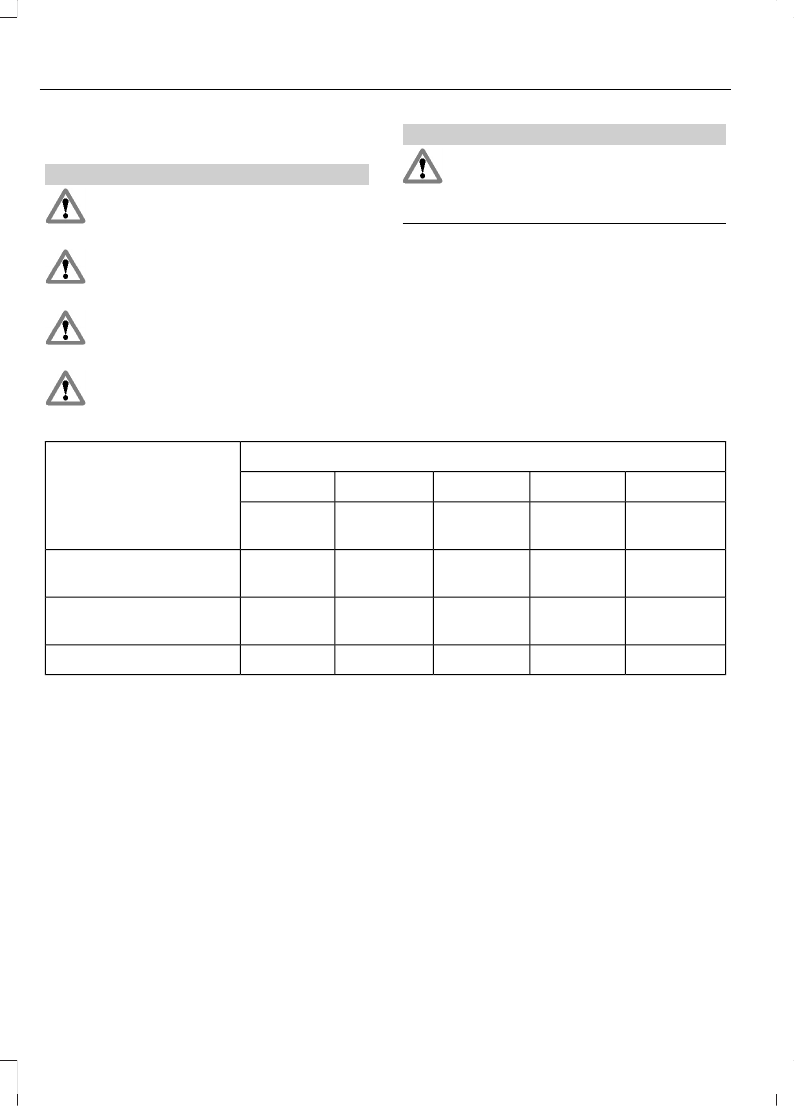Operation Manual
Table Of Contents
- Copyright ©
- Introduction
- At a Glance
- Child Safety
- Safety Belts
- Supplementary Restraints System
- Keys and Remote Controls
- MyKey™
- Locks
- Security
- Steering Wheel
- Wipers and Washers
- Lighting
- Windows and Mirrors
- Instrument Cluster
- Information Displays
- Climate Control
- Seats
- Auxiliary Power Points
- Storage Compartments
- Starting and Stopping the Engine
- Unique Driving Characteristics
- Fuel and Refueling
- Transmission
- Brakes
- Stability Control
- Parking Aids
- Cruise Control
- Driving Aids
- Load Carrying
- Towing
- Driving Hints
- Roadside Emergencies
- Fuses
- Maintenance
- General Information
- Opening and Closing the Hood
- Under Hood Overview
- Under Hood Overview
- Under Hood Overview
- Engine Oil Dipstick
- Engine Oil Dipstick
- Engine Oil Dipstick
- Engine Oil Check
- Engine Coolant Check
- Brake and Clutch Fluid Check
- Washer Fluid Check
- Changing the 12V Battery
- Checking the Wiper Blades
- Changing the Wiper Blades
- Adjusting the Headlamps
- Removing a Headlamp
- Changing a Bulb
- Bulb Specification Chart
- Technical Specifications
- Vehicle Care
- Wheels and Tires
- Capacities and Specifications
- Audio System
- Navigation
- SYNC™
- Appendices

CHILD SEAT POSITIONING
WARNINGS
See an authorized dealer for the
latest details relating to our
recommended child seats.
Extreme Hazard! Do not use a
rearward facing child seat on a seat
protected by an air bag in front of it!
When using a child seat with a
support leg, the support leg must
rest securely on the floor.
When using a child seat with a safety
belt, make sure that the safety belt
is not slack or twisted.
WARNINGS
The child seat must rest tightly
against the vehicle seat. It may be
necessary to lift or remove the head
restraint. See Head Restraints (page 83).
Note: When using a child seat on a front
seat, always adjust the front passenger's
seat to its fully rearward position. If it proves
difficult to tighten the lap section of the
safety belt without slack remaining, adjust
the seatback to the fully upright position
and raise the height of the seat. See Seats
(page 83).
Mass group categories
Seating positions
3210+0
46 - 79 lbs
(22 - 36 kg)
33 - 55 lbs
(15 - 25 kg)
20 - 40 lbs
(9 - 18 kg)
Up to 29
lbs (13 kg)
Up to 22
lbs (10 kg)
UF¹UF¹UF¹XX
Front passenger's seat
with airbag ON
U¹U¹U¹U¹U¹
Front passenger's seat
with airbag OFF
UUUUURear seats
X Not suitable for children in this mass group.
U Suitable for universal category child seats approved for use in this mass group.
U¹ Suitable for universal category child seats approved for use in this mass group. However,
we recommend that you secure children in a government approved child seat, on the rear
seat.
UF¹ Suitable for universal category forward facing child seats approved for use in this
mass group. However, we recommend that you secure children in a government approved
child seat, on the rear seat.
18
B-MAX (CB2) Vehicles Built From: 25-06-2012, Vehicles Built Up To: 31-12-2013
Child Safety










